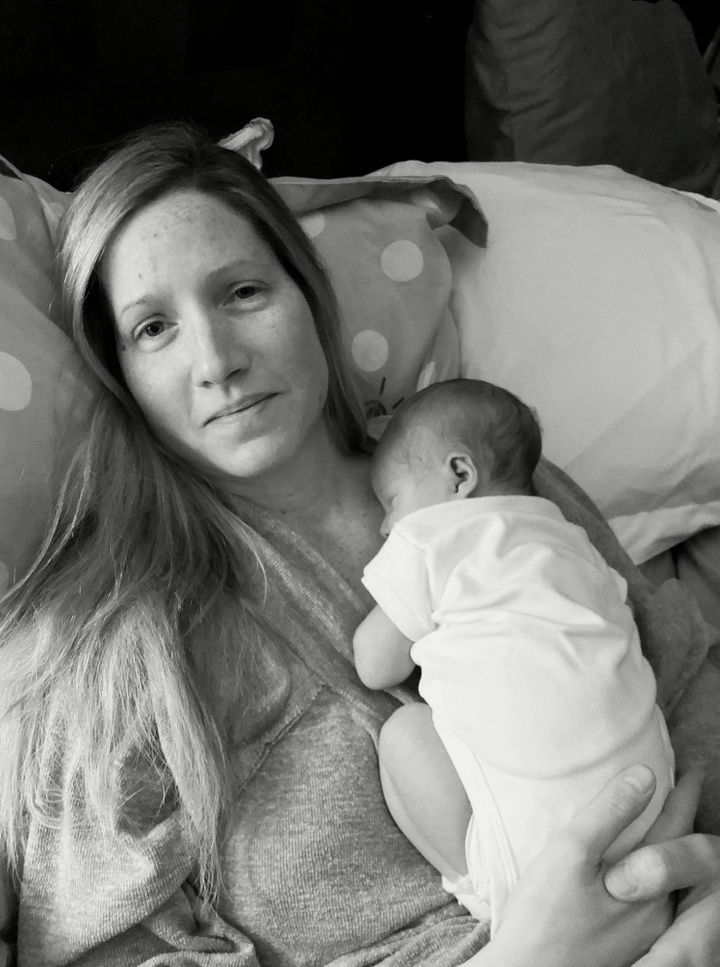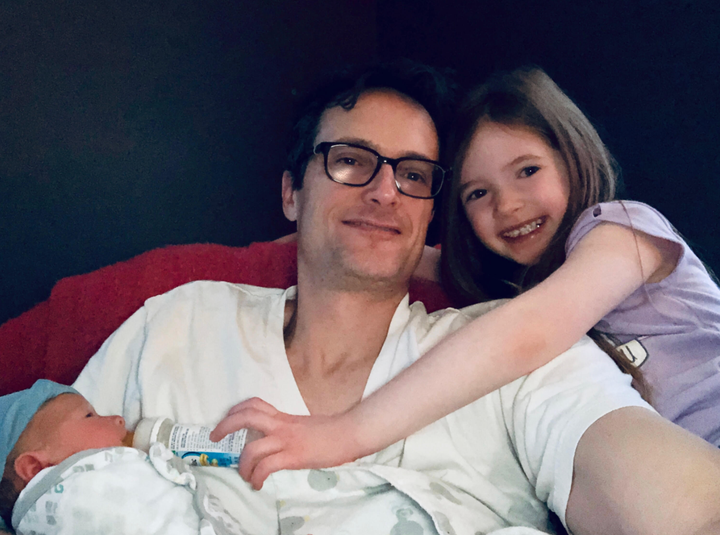
After I almost bled out during the delivery of my first child due to postpartum haemorrhage, or PPH, I had nightmares about it happening again. One week after giving birth to my second, my fears came true. I developed a pulling pain in my abdomen and called my doctor. Instinctively, I knew it was another retained placenta.
The World Health Organization recently released a road map to address PPH, the leading cause of death for women in childbirth globally. According to WHO, around 70,000 women die from PPH every year.
During the delivery of my first child, the doctor spent over 45 minutes trying to manually remove my placenta from my uterine wall. It ended up taking too long and I was losing too much blood, so I received an emergency dilation and curettage, or D&C. I returned to my hospital room after the surgery — shaking from adrenaline, pain medication, and the shock of losing so much blood — with my husband and baby by my side. I had survived — barely.
When I became pregnant with my second child, my doctors assured me that I didn’t need to worry about the same complications happening again. They said things like “you’re overthinking it” and “we have you covered if we run into any trouble.” Though I trusted my doctors, I also trusted my intuition. With my first delivery, I knew it was not normal for the doctor to be visibly frustrated when removing the placental tissue from my uterus. I always wondered: Why did it take so long for them to decide to do a D&C?
This wasn’t just anxiety-based fear. I had done my own research, and I knew that as a woman who had experienced PPH, I had a higher likelihood of having the complication again.
My fear manifested itself in panic attacks, along with nightmares about dying from bleeding out on the delivery table. I had many therapy sessions about it, and ruminated over it for days at a time. My therapist attempted to rationalize away my fear, but the intrusive thoughts continued to incessantly creep into my mind. I hoped that my providers were right and my anxiety was wrong.
When I finally faced the delivery of my second child, my son came out, but the placenta did not. Once again, the doctor spent a long time removing the tissue, and parts of the placenta were extracted like puzzle pieces, one by one. My husband and I looked at each other as my anxiety increased by the minute.
I asked the doctor if she got it all and she replied, “Yes, I think it’s all here?” Uneasy with her response, I requested an ultrasound to confirm. She wheeled forward the dated-looking machine and placed the wand on me, as a grainy black-and-white image appeared. She squinted while examining the screen and said, “It looks OK.” I glanced at my husband and felt unsure. But still heavily medicated and numb — and going against what my body was screaming at me — I let it go.
One week after delivering my son, the nightmares I had about experiencing another medical emergency due to PPH began to unfold. I called my doctor’s office with sudden acute abdominal pain. The nurse told me, “It could just be bladder retention,” but I insisted that I go in for another ultrasound. After the imaging was done, my provider came into the exam room, sat down in her chair and looked up at me. “We found retained tissue in your uterus,” she said. My anxiety suddenly rose in my chest until it took over everything and it was all I could feel. It turned out that I had been right to be worried. I was terrified.
We discussed the options — either taking a drug like misoprostol to force my body to shed the tissue on its own, or doing a D&C. I chose the latter, as I knew the sooner that all of the retained tissue was removed, the less likely it was that I would end up with an infection. I hoped the procedure would be quick and go smoothly, as I wanted to get home to my newborn.

That night, just before they took me back to the operating room, the nurse reviewed the protocol, which is now ingrained in my memory. “It will be a routine surgery,” she told me. “You will go to sleep. We will remove the remaining tissue. You will wake in recovery and then go home later this evening.” I texted my husband that I loved him, and then everything went black.
Hours later, I woke up in excruciating pain. I cried out to the nurse who was leaning over me: “It hurts! What happened!?” I was groggy from sleep medication, but I knew I felt worse than I had after delivering a child.
“Why is this happening to me?!” I loudly sobbed. The nurse put her hand on my hand and squeezed tightly. “You will be OK,” she said. I found some brief comfort in her comments, and then she pressed the pain medication button and I fell back asleep.
The next time I opened my eyes, my doctor was standing at the end of my bed. “What happened?” I asked. “You haemorrhaged again,” she said. “This time you lost over a litre of blood.” I was stunned by what she was telling me.
“When I went in to remove your retained placenta to take it out, you haemorrhaged,” she said. She paused and then added: “We put a balloon in your uterus to stop the bleeding. You are lucky to be alive.”
I started to cry. My instinct had been right. Regardless of how experienced and well trained a doctor was, no one knew my body better than I did. My husband’s face said it all when he walked into the room. He went pale when he saw the bag of blood next to my bed draining into me. “We almost lost you ... again,” he said quietly.
Twenty-four hours later, the doctor removed the device she had placed inside me, after paperwork was signed to indicate that I agreed to undergo a hysterectomy to potentially save my life if necessary. My hands gripped the sides of the bed and I prayed I wouldn’t bleed. When she was done, she gave me a look of relief and said: “I think you are going to be OK. It clotted. I don’t see any more blood.”
I stayed in the hospital for two days — more time away from my newborn son — and was eventually able to stand again using a walker. When I finally made it to the bathroom on my own, I cried over the toilet, grateful that my body was healing.
The hospital released me, and I cried again when my husband and my children came to pick me up to go home. If I hadn’t listened to my body and hadn’t pushed to have that second ultrasound, I could have lost my life. After experiencing two haemorrhages and facing death, I promised myself that I would tell people my story when I was ready, so that others would know what to do if it happened to them.
These are my biggest takeaways related to retained tissue and PPH:
- If you are experiencing some mental or physical issue during your pregnancy, explain the concern to your doctor and ask them to address it.
- This doesn’t have to be pain; if anything doesn’t feel normal, tell your doctor. You know your body better than anyone.
- If your medical team has trouble removing your placenta, ask to get a high-quality ultrasound — the type that is available at a maternal-fetal medicine doctor’s office — and not a low-quality ultrasound. My retained placenta was overlooked due to poor imaging.
- If you do not have access to a high-risk pregnancy doctor, ask your current physician if they can refer you to a specialist covered by insurance.
- If you experience new pain, especially after childbirth, talk to your doctor. New pain could signify a new problem that your doctor needs to address.
- If you have a general feeling of malaise or a fever, you should be seen as soon as possible. This can be a sign of a secondary infection, and timing is important. If you wait too long, this can result in more complex issues such as sepsis.
- If you feel lightheaded or dizzy, this can be a sign of anaemia, especially if you have experienced a complication of haemorrhage.
Here are questions you should consider addressing with your doctor:
- Are they familiar with PPH, and do they have experience with treating it? If so, what is the typical protocol in such situations?
- If they run into problems, what are the emergency plans that they will put in place and which techniques can they utilise (e.g., the use of a uterine balloon) to save your life?
- What is the protocol for dealing with retained placenta if you require treatment — or follow-up treatment — to remove it?
The best thing you can do is to be informed and advocate for yourself and your health. You could end up saving your own life — just like I did.
Lisa McCarty is a women’s health advocate. She is working on a book about infertility, and can be found on Instagram.